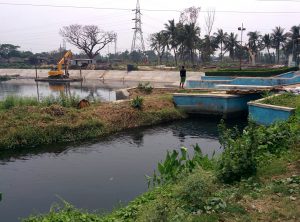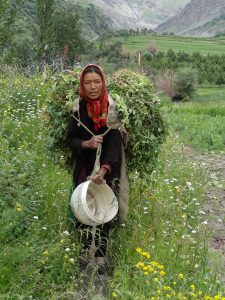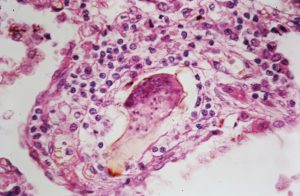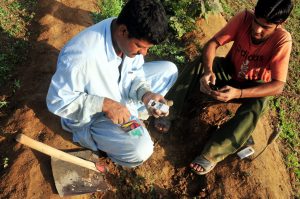An article published in the Journal of Medical Case Reports in 2014 reported that, “Chikungunya fever is not uncommon in Bangladesh… [but] Most of the cases remain undiagnosed or misdiagnosed due to lack of awareness and diagnostic facilities, the self-limiting nature of the disease and, most importantly, the prevalence of another arthropod-borne disease, dengue fever, in Bangladesh.” Barely three years later, everybody knows the name of the mosquito-borne viral disease. An explosive outbreak has infected thousands, with the government being called on to classify it as an epidemic.
First diagnosed in Tanzania in 1952, the name Chikungunya derives from a word in the Kimakonde language that means “to become contorted”. This refers to the acute joint pain that accompanies high fever in the people caused by the disease. Since that time the disease has travelled out of West Africa, driven by global interconnectivity, and mutations in the genome of the disease. But one of the most important drivers of the spread of the disease has been climate change which has expanded the range of the Aedes species of mosquito.
Bangladesh, a country which already had the climatic conditions – basically hot and humid – to allow for the breeding of these mosquitoes, had relatively rare cases of the disease. It was, though, considered a high-risk nation with respect to mosquito-borne diseases as the impoverished state of over about 160 million people is especially vulnerable to virus preparation because of insufficient biosecurity and deficient disease surveillance.
The result of these gaps is now there for all to see as Chikungunya rampages through the population.
Thousands infected
According to the country’s Institute of Epidemiology, Disease Control and Research (IEDCR) under the Health Ministry, a total of 2,700 Chikungunya cases have so far been reported by hospitals and clinics in Dhaka since May. The disease has spread so much fear among the public that a lawyer has recently moved the High Court seeking compensation for the victims from the government.
Syeda Tasnim Mona is a school teacher who lives in Dhanmondi area in Dhaka, Bangladesh’s capital city. She was infected by the Chikungunya virus in March, and then each one of her family members was also infected and suffered from the Chikungunya fever. “When I went to hospital first they weren’t able to diagnose [what was wrong]. I had to go for several medical tests. The doctors had no idea about the disease. Then I went to ICDDR,B and they confirmed that I was suffering from Chikungunya,” she said.
There are no specific antiviral drugs and no commercial vaccine for the disease, which is largely treated symptomatically. Mona stills feels pain in her joints and different other parts of her body. She said, “In each and every family in Dhaka, you can find Chikungunya patient. This is a very common scenario now in Dhaka.”
Professor Meerjady Sabrina Flora, head of the IEDCR said the disease virtually swept through over capital Dhaka areas in June and its spread is continuing. She said they are currently getting up to 100 calls from Chikungunya patients or their relatives every day through a hotline they opened recently at their office in Dhaka.
Speaking to the media, she said that the prevailing situation may continue or even worsen until the end of September this year as Aedes mosquitoes could breed even after the end of the monsoon season.
Blame game
Meanwhile, different government departments and agencies responsible for disease control are blaming one another for the epidemic or outbreak. None of them is ready to accept responsibility.
The Ministry of Health and family welfare held the Dhaka City Corporation responsible for the spread of the disease, saying that the municipal authorities had failed to eradicate mosquitoes. Dhaka North City Corporation (DNCC) mayor Annisul Huq countered by saying the disease had been spread by mosquitoes that bred at home, not those that bred in drains and marshes, and which the municipal authorities are supposed to handle.
Epidemic?
By and large, Chikungunya is currently reported to be confined to Dhaka. But that may be because the disease is not being diagnosed elsewhere in the country. IEDCR is the only institute in the country with Chikungunya testing facilities. According to it, one in every 11 patients is suffering from this disease in Dhaka.
The government, though, insists that the situation is under control. The director general of Health Services in Bangladesh Professor Abul Kalam Azad said that the government is well aware of the situation. He said that many measures have been taken to contain further outbreak of Chikungunya in Dhaka and other parts of the country.
As yet, there is no sign that any of the measures has had any effect, and as each. More problematically the test costs BDT 8,000 to 10,000 (USD 100 to 125) to do, a substantial expense for the poor. This sudden, wide outbreak will cost the country much, whether it chooses to call it an epidemic or not.
![<p>Aedes aegypti mosquito [image by: James Gathany/Public Health Image Library]</p>](https://dialogue.earth/content/uploads/2017/08/Aedes.jpg)








